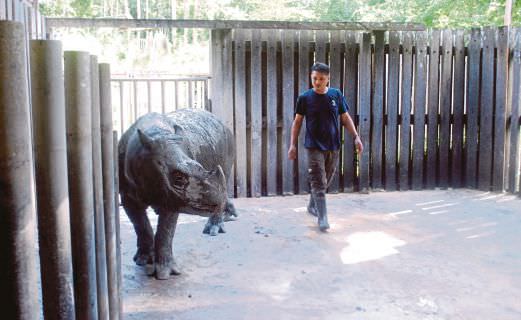IT is hard to convince Wilson Kuntil that there are no more rhinoceros in Malaysia. The 35-year-old caretaker of possibly the last three Sumatran rhinos in the country refuses to believe it.
“It’s hard for me to accept this. I know many scientists say it’s going extinct, and I know many out there in the jungle looking for the rhinos will say the same thing. But I can’t get myself to say they are gone.
I don’t want it to go extinct,” said the head keeper at the Borneo Rhinoceros Sanctuary at the Tabin Wildlife Reserve in Lahad Datu.
“If you have looked after one as long as I have, maybe you will feel the same way,” said the Borneo Rhino Alliance (Bora) worker with a faint smile.
For five years, Wilson has looked after Kertam, the only male among three living in the sanctuary.
He is hoping against all odds that things will turn out for the better. The two females are Puntung and Iman, both deemed by experts as incapable of naturally bearing any offspring for Kertam.
“I am no expert but if it’s one thing I know, it’s how to look after Kertam and I will make sure he is in the best of shape when a suitable partner is found for him.”
Then, he turned and called out to Kertam: “Boleh kan Tam Tam?” Kertam turned its head, snorted and went back to wallowing in its mud pit. Wilson and six other keepers look after the three rhinos round the clock.
They feed, clean, nurse and protect them within a paddock that leads to an enclosed jungle, where the trio roam. The keepers live in quarters just a few metres away from the paddock.
Everyday, they take turns to inspect the three fenced jungle areas, one each for the rhinos. During bad weather, they risk their lives going inside the beasts’ territories to make sure all three are safe from fallen trees.
Another team is in charge of growing plants of leaves, shoots and fruits to feed the rhinos.
Since Bora began its programme in 2010, more than 120 species of plants have been identified as food for the rhinos, although each of the three has its own preference.
Ronald Jummy, who chats with Iman during feeding time, says it has become a habit for him as he considers the rhino like his own child.
“Sometimes, Iman will be choosy, sometimes moody, but there are days when she can be friendly and playful,” said the 29-year-old keeper, who rewards the rhino with a rub on its ears if “she is a good girl”.
Despite his attachment to Iman, which has been under his care for over a year since its capture in Danum Valley, he knows his limits.
“A rhino is a big animal and a small nudge can knock you down. Iman is the most aggressive of the three because she’s not used to people, unlike Kertam and Puntung, that have been in captivity much longer.” Samat Gubin, who looks after Puntung, says they prepare the food and hand-feed the rhinos twice daily.
“After feeding, the rhinos will go back to their jungles and wallow in mud,” he said, adding that food will also be tied in branches nearby in case “they get hungry at night”.
Apart from occasional snorts and faint squeaks they make while eating, the rhinos do not make much noise.
“It’s only when they see each other or mate, then you can hear them from as far as 1km away,” Gubin said, describing the eerie bellowing that rhinos make when they fight or warn their enemies.
Bora field manager and veterinarian Dr Zainal Zahari Zainuddin says there have been a few unsuccessful attempts by Kertam to mate with Puntung.
“For big animals, mating is a complicated process and for rhinos, in particular, the male needs to win over Puntung before she will allow any advances.
To do that, the two will fight. The act of mounting a female, too, is a big effort for a male as it will need to conserve its energy for that .”
Dr Zainal says the rhinos will also be protective of its own territory and react to the slightest whiff of “intruders” with its strong sense of smell.
For now, with Puntung or Iman not in the best of health, the field team has to collect the sperm from Kertam and eggs from the two females.
“We have a highly-dedicated team here who treats the three rhinos with great respect and care. We just have to,” he said.
– http://www.nst.com.my







